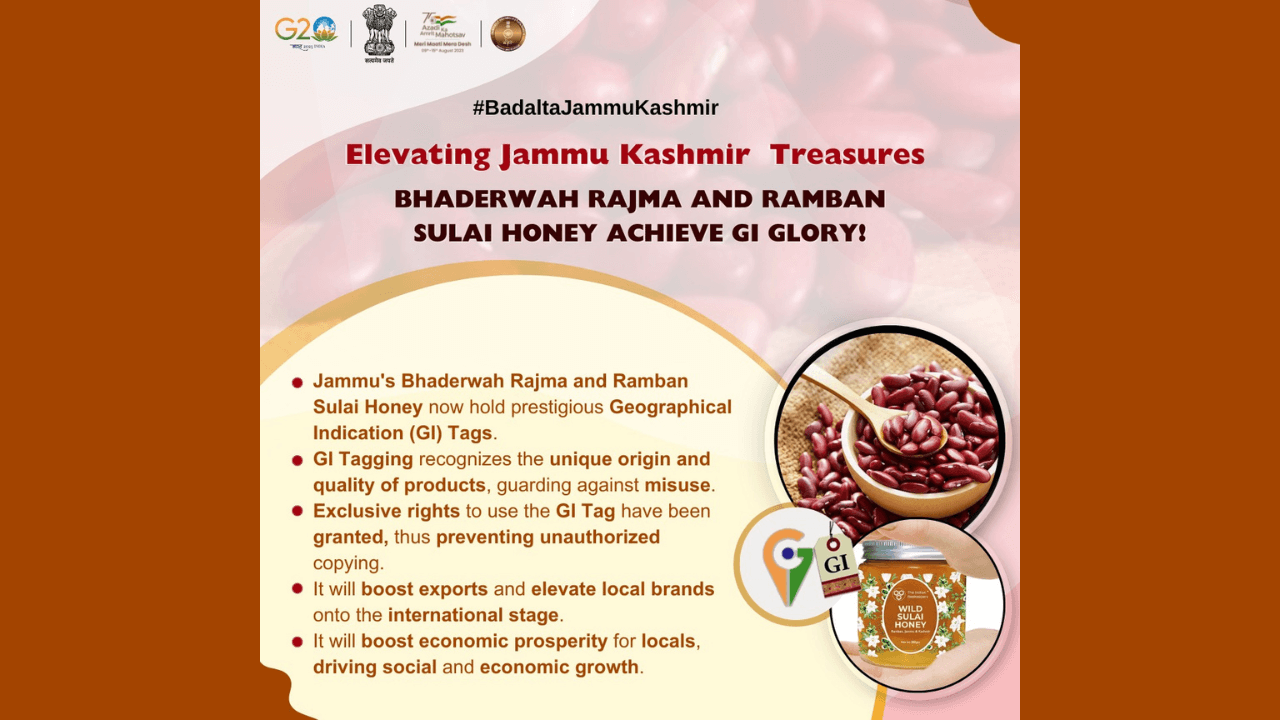In a noteworthy development for the region, Bhaderwah Rajmash and Sulai honey, which originates from the scenic districts of Doda and Ramban in Jammu and Kashmir, have received the prestigious GI Tag. These tags underscore the distinctive features and attributes of these regional delicacies, paving the way for their global promotion and acknowledgment.
Significance
- The Department of Agriculture and Farmers Welfare in Jammu initiated the process of obtaining Geographical Indication (GI) tags for these products.
- The GI tag grants exclusive usage rights to authorized users while safeguarding against unauthorized exploitation.
- This recognition is anticipated to boost exports, enhance international brand recognition, and deter misuse.
- Ultimately, the GI tag is poised to bolster local economies and foster socioeconomic growth for the producers.
Recently, Rajouri’s Chikri Wood Craft and Mushqbudji Rice also received GI Tags.
About Bhaderwah Rajma

Bhaderwah Rajmash, commonly known as red beans, occupies a unique spot in the affections and tastes of the people in the Chenab Valley. Its unique taste and texture make it not just a dietary staple but also a cultural emblem of the region.
About Ramban Sulai Honey

The second Geographical Indication (GI) tag has been granted to the honey produced in Sulai, situated in the Ramban district. Sulai honey is renowned not just for its delightful flavor but also for its organic qualities. In a remarkable gesture in 2015, Prime Minister Narendra Modi presented organic Sulai honey to Queen Elizabeth during his visit to Britain, highlighting the region’s natural richness to the global audience.
About GI Tag
- A geographical indication (GI) is a designation or symbol assigned to products originating from a particular geographical area.
- GIs serve as a certification that these products are crafted using traditional techniques or possess distinct characteristics tied to their place of origin.
- These designations are applicable to a wide range of items, including food, handicrafts, and industrial products.
- Importantly, the GI tag guarantees that only authorized individuals or entities are permitted to employ the product’s name, safeguarding its integrity and origin.
Who grants and regulates Geographical Indications?
- Geographical indications (GIs) fall under the category of Intellectual Property Rights (IPRs).
- They are acknowledged and safeguarded under the Paris Convention for the Protection of Industrial Property.
- At the global level, the World Trade Organization (WTO) has established the Agreement on Trade-Related Aspects of Intellectual Property Rights (TRIPS) to offer a framework for the protection of GIs.
- In India, the registration and safeguarding of GIs are overseen by the Geographical Indications of Goods (Registration and Protection) Act, 1999, which became operational in September 2003. This legal framework ensures the proper recognition and protection of India’s unique geographical origin-based products.
- Weekly Current Affairs 2025 PDF For Bank, SSC, UPSC Exams
- Unsung Heroes of India: 10 Unknown Freedom Fighters You Should Know
- 26 December Current Affairs 2023 in English
- Daily Current Affairs 2025, Check Today’s Current Affairs
- April Month Current Affairs 2024, Download PDF
- June Month Current Affairs 2024, Download PDF

Hello, I’m Aditi, the creative mind behind the words at Oliveboard. As a content writer specializing in state-level exams, my mission is to unravel the complexities of exam information, ensuring aspiring candidates find clarity and confidence. Having walked the path of an aspirant myself, I bring a unique perspective to my work, crafting accessible content on Exam Notifications, Admit Cards, and Results.
At Oliveboard, I play a crucial role in empowering candidates throughout their exam journey. My dedication lies in making the seemingly daunting process not only understandable but also rewarding. Join me as I break down barriers in exam preparation, providing timely insights and valuable resources. Let’s navigate the path to success together, one well-informed step at a time.






